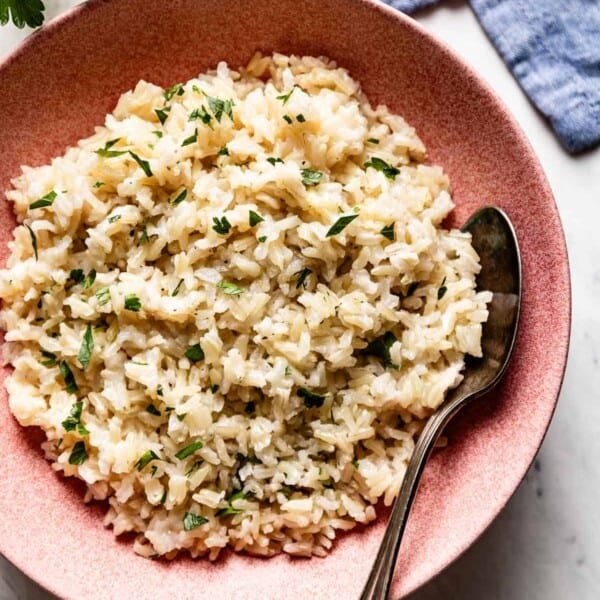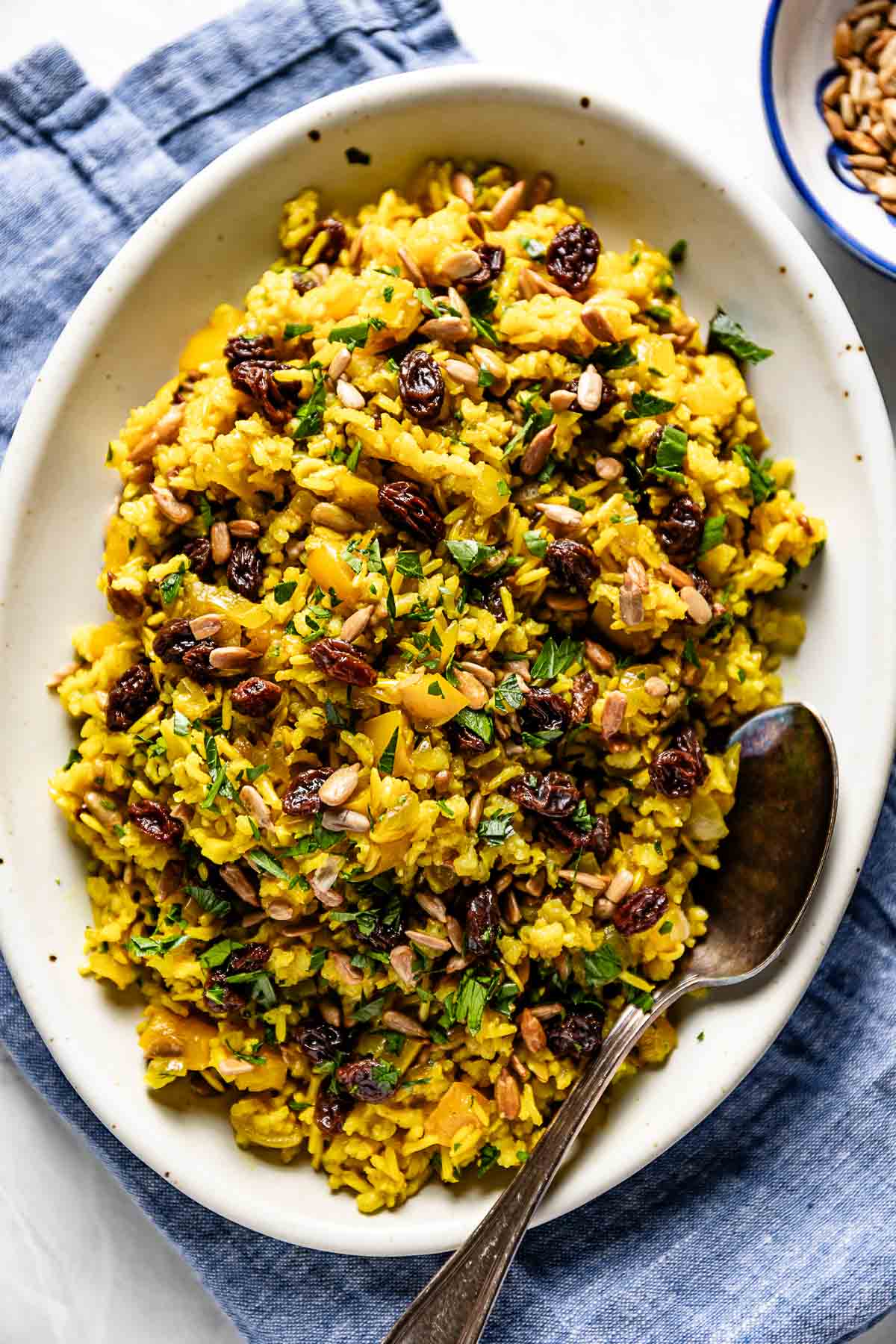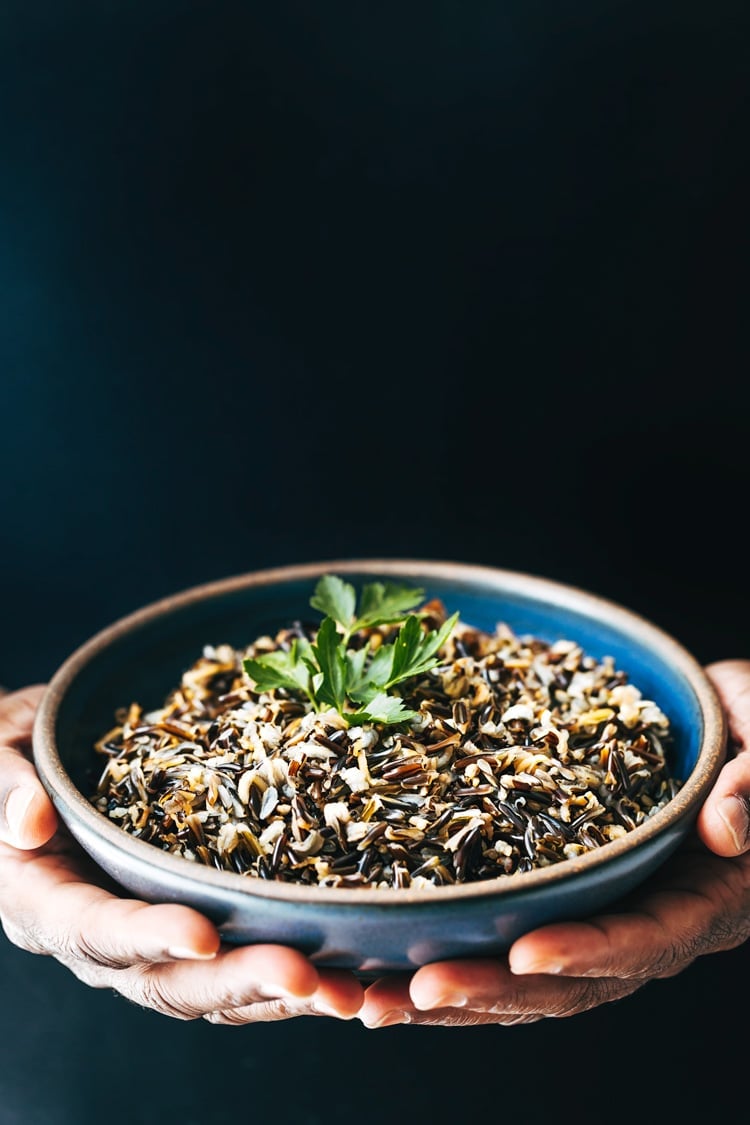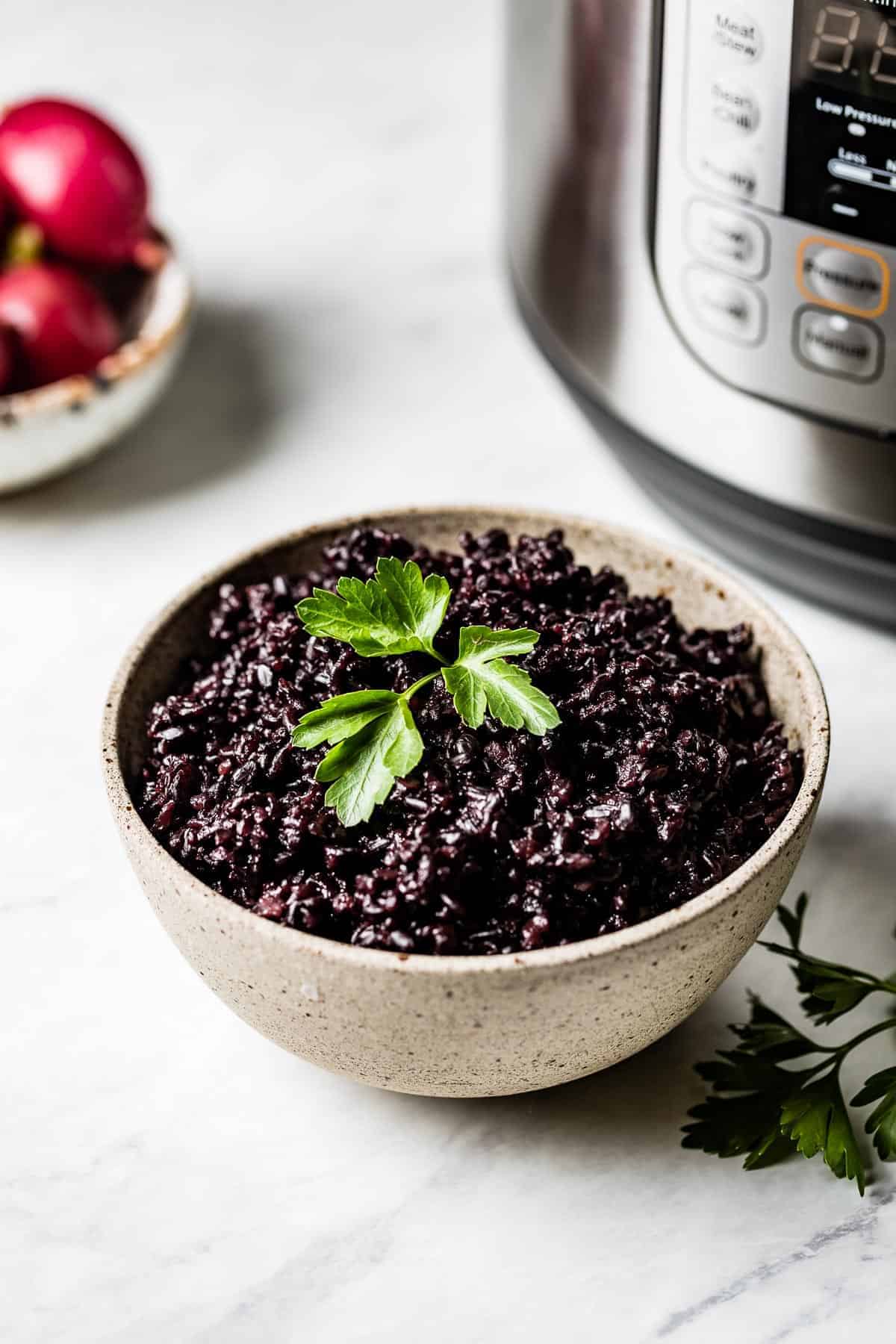We love our whole grains for their nutty flavor, extra dietary fiber, and wholesome nutritional value. But nothing smells like comfort to me more than a pot of rice cooking away on the stove. And if you are into whole grains as much as I am, consider this as a guide to perfect brown rice every time.
If you want to learn more, we have a great library of whole grains, including Black Rice, Bulgur Wheat, Quinoa, and Wild Rice.
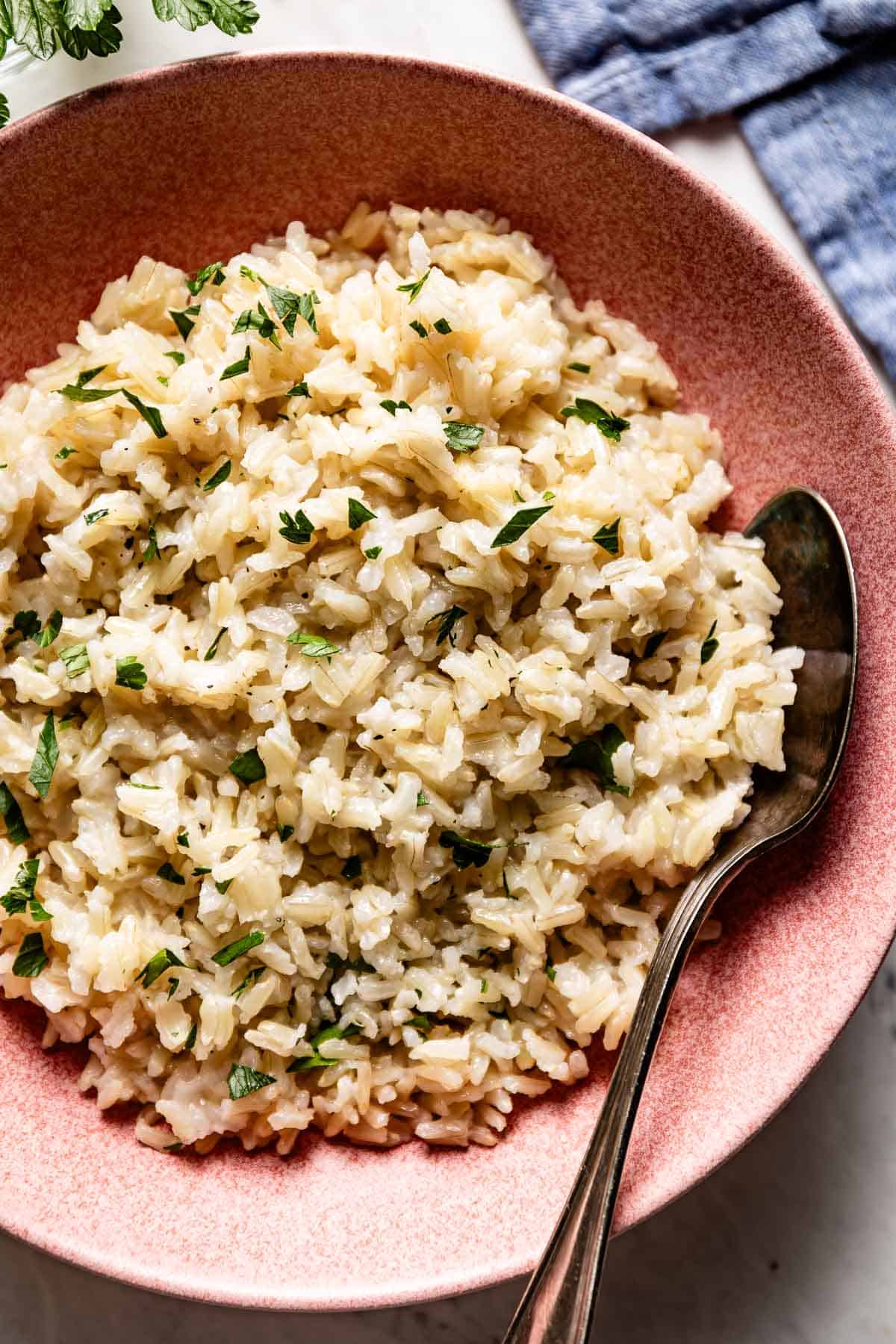
Ingredients You’ll Need to Make Jasmine Brown Rice
In and of itself, jasmine brown rice is a 2-ingredient recipe. The additional ingredients add that much more flavor, character, and color. We will need:
- Rice: Brown jasmine rice, also referred to as whole-grain jasmine rice, brown Thai rice, jasmati brown rice, or unpolished rice, is a type of long-grain brown rice coming from Thailand and Southeast Asia. Its distinctive light brown color comes from retaining the outer layers, which are removed, along with the germ, to create white jasmine rice. Because jasmine brown rice is a whole-grain rice, it has a slightly matte finish, nutty taste, and chewy texture. You can find it in the global section of the grocery store, specialty Asian markets, or even online. My favorite brands are Lundberg organic brown jasmine rice (affiliate link) and Mahatma Jasmine Brown Thai Fragrant Whole-Grain Rice (affiliate link). We tested this recipe using these two brands of rice.
- Cooking liquid: Water is the most common cooking liquid for rice and offers the easiest approach. With that being said, you can add more flavor by swapping the water for Chicken Stock, Vegetable Broth, or Veggie Scrap Stock instead.
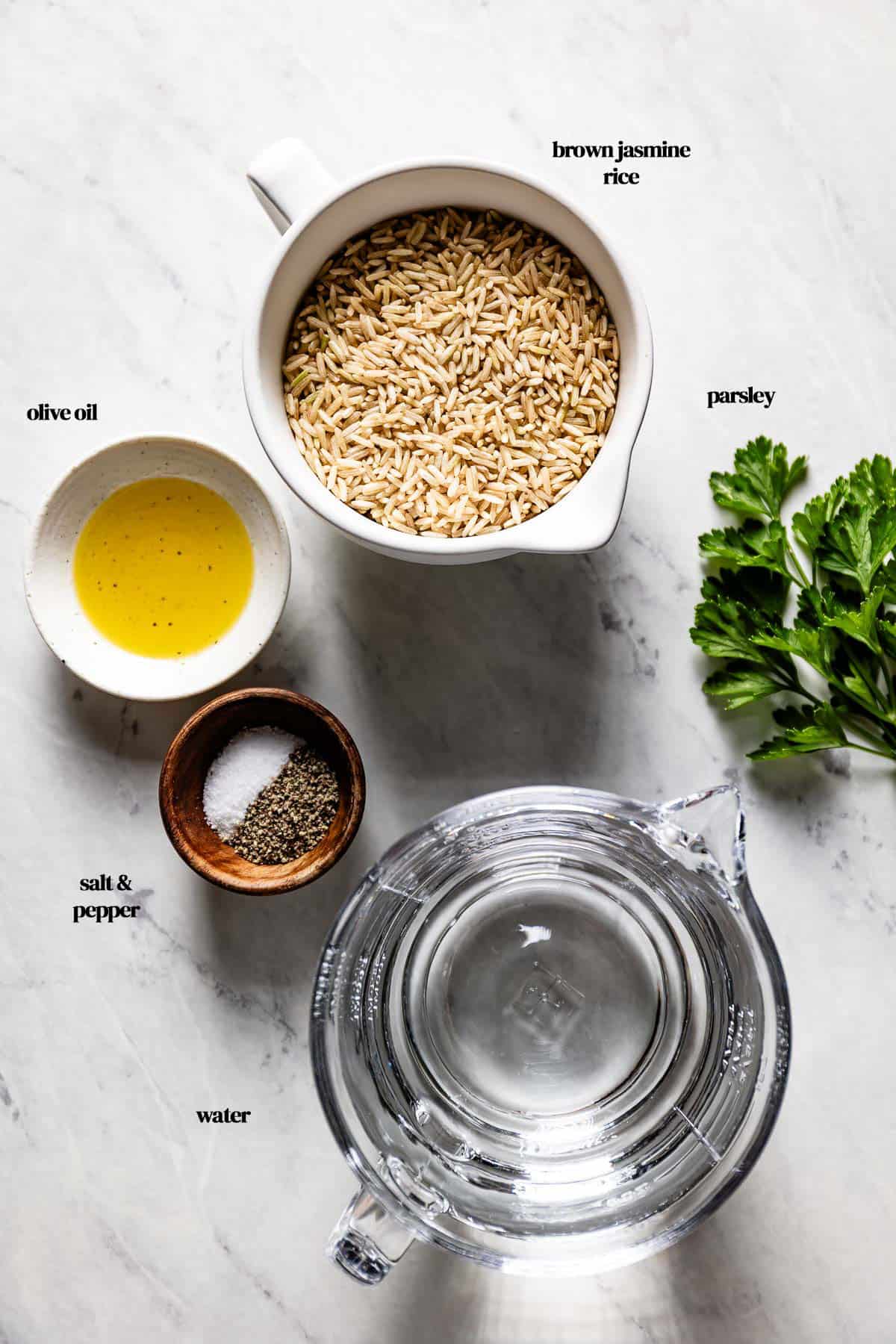
Optional Add-Ins
While the below additions are optional, I chose to use them in the recipe for extra flavor. Luckily, they are ingredients that you probably already have on hand.
- Olive oil or butter: To give the rice a glossy sheen and extra flavor, add 1-2 tablespoons olive or butter right into the cooking liquid.
- Kosher salt: Adding salt at the beginning of cooking will enhance the natural flavor of the rice.
- Black pepper: For some slight heat, I like to add freshly ground black pepper after the rice is done cooking.
- Fresh herbs: A sprinkle of fresh parsley at the end adds both color and flavor. However, feel free to adjust the herbs you choose based on the dish you are serving it with. I usually pair it with different herbs that complement Asian flavors, like cilantro, mint, basil, or scallions.
Brown Jasmine Rice Cooking Instructions (Stovetop)
This Thai brown jasmine rice recipe is a cinch to make. Since brown rice takes longer to cook than white rice, the hardest part is waiting for it to finish on the stove. Here’s how I like to do it:
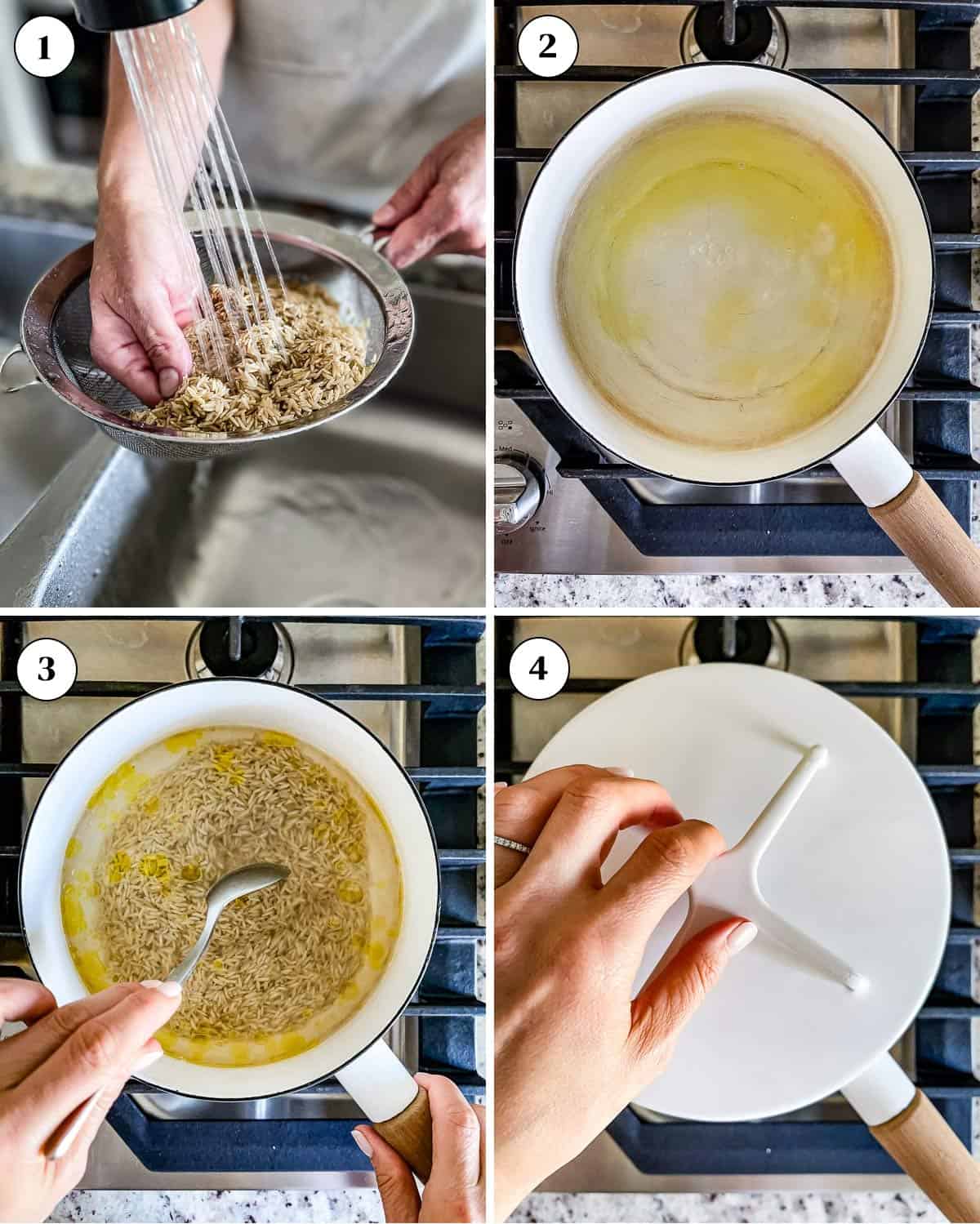
- Rince rice: Place rice in a colander and rinse under cold water until the water runs clear, 20-30 seconds.
- Boil water: In a heavy-bottomed, medium saucepan over high heat, add 2 cups of cooking liquid, along with the olive oil and salt (if using). Bring to a boil.
- Add rice: During our recipe testing, we found that the best brown jasmine rice-to-water ratio is 1:2. Therefore, as soon as your cooking liquid comes to a boil, add 1 cup of rinsed and drained rice to the cooking liquid.
- Cover and cook: Cover with the lid, and reduce the heat to low. Simmer for 30 minutes without opening the lid. After 30 minutes, open the lid and check to see if the liquid is fully absorbed. If not, continue to simmer in 3-minute increments until the excess water has been absorbed.
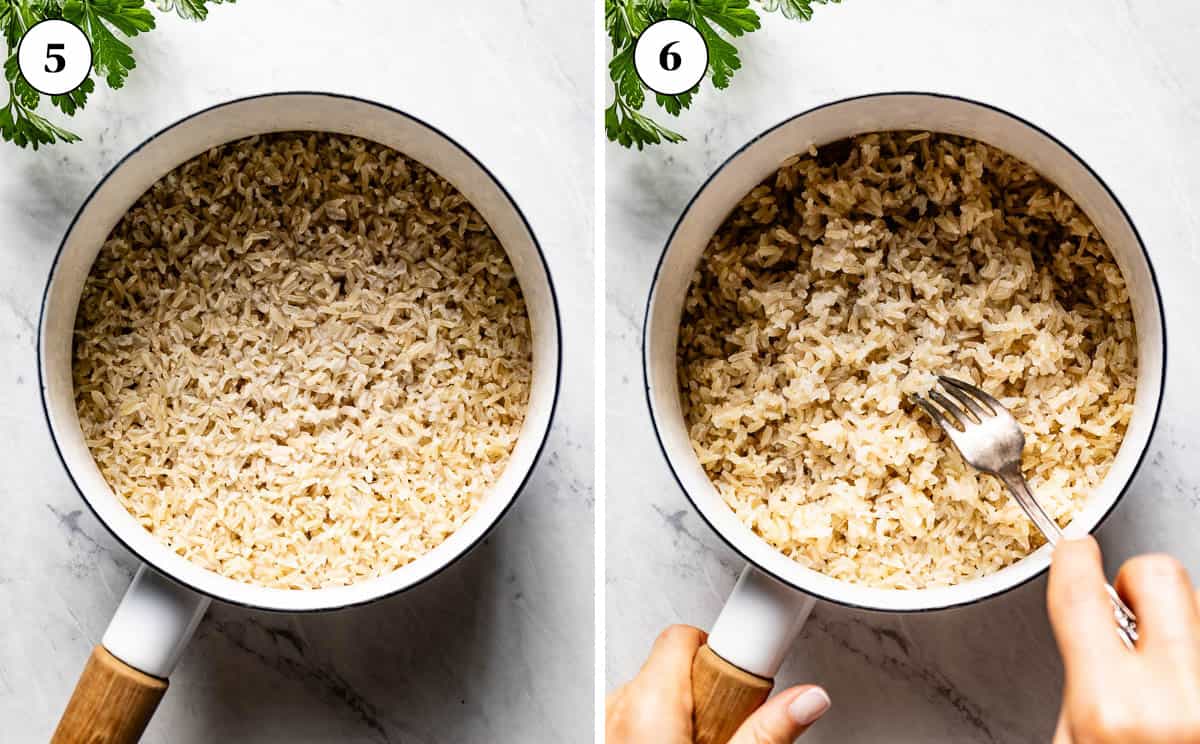
- Rest: Remove from the heat and rest the rice for 10 minutes with the lid on.
- Fluff and serve: Gently fluff the rice with a fork. Season with black pepper and parsley, if desired. Serve.
How to Store and Reheat
Stovetop brown jasmine rice is a wonderful meal prep recipe. I like to keep a container of this whole grain in either the fridge or freezer so I can have a hearty side dish ready at a moment’s notice. To store properly, simply:
- Storage: You can keep leftover rice in an airtight container in the fridge for up to 5 days. Just be sure to first bring it to room temperature before storing it.
- Freezing: To freeze, first cool completely by spreading the rice out onto a baking sheet (this speeds up the process and prevents the formation of ice crystals in the freezer). Transfer to heavy-duty freezer bags or freezer-safe airtight containers with some room at the top for expansion. (If you are big into meal prep, package in 1-2 cup portions so you only pull out what you need.) Label, date, and freeze for up to 1 month.
- Thawing: Thaw frozen rice overnight in the refrigerator.
- Reheating: Splash a few tablespoons of water on the rice to rehydrate. Microwave on high in 30-second increments, stirring each time in between, until warmed through. Or steam or stir-fry in a skillet on the stove.
Other Methods of Cooking Brown Jasmine Rice
Brown Jasmine rice is just like any other rice, in that it can be cooked following a different cooking method. Some other methods of cooking Thai jasmine rice include:
- In a Rice Cooker: Follow the ratio of 1 ½ cups liquid to 1 cup of uncooked rice. Place in your rice cooker and set it to the ‘Rice’ setting (or ‘Brown Rice’ setting, if your cooker has it). When done cooking, fluff it and serve.
- In the Instant Pot: Follow the ratio of 1 ¼ cups liquid to 1 cup of rice. Place in the pressure cooker, set the vent to ‘Sealing’ position, select ‘Manual’ on high pressure, and set the cooking time to 20 minutes. Once done, allow the pressure to naturally release for 10 minutes, then manually release the remaining pressure. Fluff it with a fork and serve. For more information, check out our detailed post on cooking brown jasmine rice in the instant pot.
To make it easier, below is a breakdown of the brown jasmine rice-to-water ratio for each method of cooking:
| Method | Rice Amount | Water Amount | Cook Time | Notes |
|---|---|---|---|---|
| Stove Top | 1 cup | 2 cups | 30-40 minutes | Check after 30 minutes. |
| Rice Cooker | 1 cup | 1 1/2 cups | 40-60 minutes | The timing might change based on your rice cooker. |
| Pressure Cooker | 1 cup | 1 1/4 cups | 23 minutes | Plus, 10 min each to come to pressure and release. |
Serving Suggestions
Brown rice is an incredibly versatile side dish that can be served just as is with stir-fried vegetables, added to soup and salads, turned into grain bowls, and in some cases, even transformed into dessert-like rice pudding. Make it a great addition to any of your favorite meat, chicken, seafood, and vegetarian meals. A few of my favorites are:
Expert Tips
For the best brown jasmine rice recipe, be sure to follow these expert tips:
- Do not skip rinsing the rice: Rinsing removes the excess starch on the coating of the rice, resulting in light and fluffy grains. Place the rice in a fine-mesh strainer and rinse under cool running water until the water runs clear.
- Keep the lid on: The key is to cook the rice over consistent heat, low and slow, so you want to refrain from opening the lid while cooking. In other words, no peeking.
- Use a thick-bottomed saucepan: The thick bottom of the pan serves as a protective barrier, preventing the rice from burning or sticking. In addition, it ensures even heat distribution, resulting in perfectly cooked brown jasmine rice with uniform consistency.
- Make sure to rest: The key to perfectly cooked rice is resting it for 10 minutes, with the lid still on, as soon as you remove it from the heat. This essentially steams the rice all the way through.
- Fluff: When ready, use a fork to gently fluff the rice. Doing so helps release steam and separate the grains, resulting in a soft, airy texture.
- Get creative: Don’t be shy when it comes to cooking rice the way you want it. Use any cooking liquid of your choice, throw in some aromatics like garlic cloves and bay leaves, and finish with herbs and seasonings like parsley, cilantro, basil, chives, red pepper flakes, and more.
FAQs
The cooking time for brown jasmine rice is anywhere between 30-40 minutes when cooking on the stove. Be mindful of the cooking liquid and cook until all the liquid is absorbed and the rice is tender.
There are two varieties of jasmine rice: white and brown. Brown jasmine rice is considered a whole grain because it contains the endosperm, bran, and germ.
Jasmine rice comes in two forms: white and brown. Brown jasmine rice boasts a tan color, a chewy texture, and an earthy flavor. On the other hand, white jasmine rice has a white appearance, with a tender yet slightly sticky texture, and is accompanied by a delightful floral aroma.
Brown jasmine rice is tan to light brown in color, with long and slender grains. The finish is somewhat matte, thanks to the presence of the bran layer.
If you try this Jasmine Brown Rice Recipe, please take a minute to rate the recipe and leave a comment below. It helps others who are thinking of making the recipe. And if you took some pictures, be sure to share them on Instagram using #foolproofeats so I can share them on my stories.
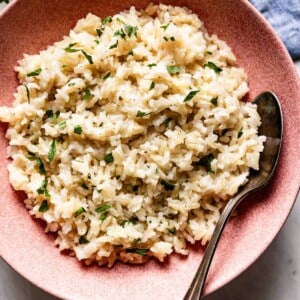
How To Cook Brown Jasmine Rice
Ingredients
- 2 cups water*
- 1 cup Brown Jasmine Rice*, thoroughly rinsed*
Optional add-ins:
- 1 tablespoon olive oil
- 1 teaspoon Kosher salt
- ½ teaspoon ground black pepper
- 1 tablespoon parsley, chopped, optional
Instructions
- Place your cooking liquid in a medium-sized saucepan over high heat. If using, add in olive oil and salt as well. Cover and bring it to a boil.
- Add the rice, stir to combine, and bring it to a rolling boil. Put the lid on and turn the heat down to low. Simmer for 30 minutes without opening the lid.
- At the end of the 30 minutes of simmering, open the lid and check whether or not the liquid is fully absorbed. If it hasn’t, then continue to simmer at 3-minute increments until no liquid is left.
- Turn the heat off and let it rest for 10 minutes with the lid on.
- When ready to serve, gently fluff it with a fork.
- If preferred, season with black pepper and garnish with chopped parsley. Serve.
Notes
- Yields: This recipe yields about 3 ½ cups cooked. A side serving is suggested at ½-1 cup, so it would be good for approximately 4 servings. The nutrition facts below are per serving.
- Cooking liquid: If you want to add more flavor, you can vegetable stock or chicken broth in place of water.
- Do not skip on rinsing: Rinsing the rice is an important step as it helps remove any additional starch. The best method is to place the rice in a mesh strainer and rinse it under cold water, stirring with your fingers or spoon.
- Jasmine Brown Rice: We tested this recipe using two different national brands: Lundbery Organic Jasmine Brown Rice and Mahatma Jasmine Brown Rice. They yielded similar results in terms of cooking time and the amount of cooked rice. However, please keep in mind that the age of the rice plays an important role in the final product. The fresher the rice, the more fragrant it will be. Additionally, if you decide to purchase brown jasmine rice from the bulk bin, the time of cooking might be different. We recommend using the visual cues we listed within the blog post to gauge doneness.
- Storage: You can keep leftover rice in an airtight container in the fridge for up to 5 days. Just be sure to first bring it to room temperature before storing it.
- Freezing: To freeze, first cool completely by spreading the rice out onto a baking sheet Transfer to heavy-duty freezer bags or freezer-safe airtight containers with some room at the top for expansion. If cooking Thai jasmine brown rice is a part of your meal prep, I recommend packaging it in 1-2 cup portions so you only pull out what you need. Label, date, and freeze for up to 1 month.
- Thawing: Thaw frozen rice overnight in the refrigerator.
- Reheating: Splash a few tablespoons of water on the rice to rehydrate. Microwave on high in 30-second increments, mixing each time in between until warmed through.
Nutrition
Nutrition information is automatically calculated, so should only be used as an approximation.
